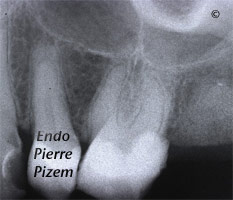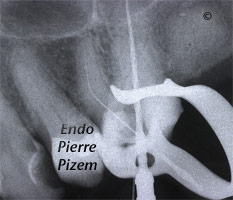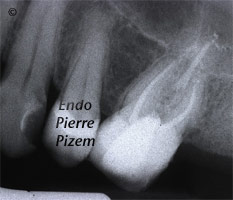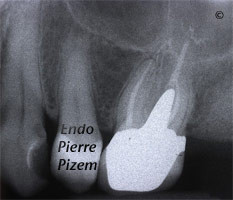A New Dental Operative Microscope (D.O.M.) Assisted Root Canal Treatment in a Calcified Maxillary Molar Abutment.
Microendodontic. Case Study Number 27526
Acute pain on this maxillary molar is keeping the patient awake all night long. Pain started following a recent filling replacement. This is an irreversible pulpitis diagnosis, patient has been referred for endodontic therapy with the help of a dental operating microscope.
Radiographic findings: Dystrophic calcifications in the whole canal system are completely obliterating the pulp chamber as well as the root canals themselves. It can be expected that the root canal entries are completely embedded in a mass of adherent pulp stones. Root canal procedure is difficult because of calcified canals.
Endodontic procedure problem number one to solve: Exposing color map of dentin prior to locating root canal entries without perforating pulpal chamber floor and without destroying to much sound tooth structure in order to keep tooth restorable.
Endodontic procedure problem number two to solve: Cleaning and shaping located root canals without loosing patency, without breaking an endodontic file and without perforating the root.
A few years back, when there was no surgical operating microscope in our dental practices and only a handfull of daring (and caring) pioneers in microendodontics trained by Dr Garry B. Carr (who is an endodontist acknowledged to me as the “father of microendodontics”), removing this symptomatic molar and replacing it by an implant supported crowns would have been a good option to consider for most of us.
In order to save that tooth, calcified dentin must be carefully removed with long thin ultrasonic tips under the high magnification of dental operating microscope (OPMI PROergo from Carl Zeiss). No rapid technique exists for dealing with calcified root canal systems. Root canals where shaped and cleaned with Protaper endodontic files and 06, 08,10 K in combination with chelating agent (RC PREP). Canal system has then been filled with Pulp Canal Sealer and Gutta percha laterally and vertically condensed. Provisional filling material: Cavit.
Last X Ray dental film is a post operative control, a crown with a perfect fit that was done by the referring dentist will warrant a good seal.





The job of dentist is really difficult but appreciable. It requires healthy environment and dental equipment is used in safe way. Many patient suffering from dental problems. Thanks for sharing such great information.